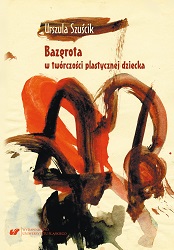Bazgrota w twórczości plastycznej dziecka
Scribble in the child’s artistic creation
Author(s): Urszula Szuścik
Subject(s): Social Sciences, Education, Fine Arts / Performing Arts, Psychology, Sociology of Art
Published by: Wydawnictwo Uniwersytetu Śląskiego
Keywords: Scribble; visual perception; artistic creativity;stimulation;
Summary/Abstract: The book presents the assumptions and results of the pedagogical experiment on the genesis of scribble and its transformation by stimulation of visual perception. The study involved children aged 2 and 3 years. As we know, the scribble period is one of the most difficult periods to study in the development of child’s drawing creativity. During this time, the areas of cognitive, enactive and communicational development of the child are formed and integrated. It is a discovery for the child to have left the first graphic trace. I asked myself a question concerning the extent to which the child’s visual stimulation determines his/her original drawing – a scribble. To what extent does his/her visual stimulation change as a result of this impact in terms of the diversity of linear quality, colour patches and shapes – figures? What, therefore, new formal features does the scribble acquire? These are some of the questions I tried to answer in the present work. My approach to the analysis of children’s scribbles rests upon my assumption that this is a kind of specific endeavor able to rebuild the child’s visual and motor experience by means of stimulation of his/her visual perception. The research hypothesis involved the stimulation of children’s artistic creativity depending on the shaping of their visual perception by strictly defined visual stimuli within colours, lines and figures. Visual stimuli formed perceptual patterns determined by individual research tasks. The experiment covered 15 exercises, including five exercises on colors, five on lines and five on figures. The book consists of three main chapters and extensive appendices. I discussed the issue of a scribble in the development of the child’s artistic expression in the first chapter of the work, referring to the concept of the development of artistic creativity and visual perception of selected researchers. I described the development of visual and artistic values in a child’s scribble, namely a line, a color patch, a circle and a figure. I attribute a special role to the development of the child’s visual perception. Moreover, I think that the formation of the semantic aspect of the scribble is one of the elements of the child’s cognitive development that leads to thought-drawing transformations. This issue is presented in the theoretical analysis of the work. Child’s scribbling was an inspiration for many artists; that’s why I have resolved to discuss this topic in this chapter. Seeking answers to this problem, I have contrasted selected examples of children’s scribbles and works of art. In my opinion, what combines them in the beauty of the simplicity of artistic solutions is creative intuition. In the second chapter of the work, I have presented the assumptions of my research, research problems, adopted hypotheses, research procedure, variables and indicators. The whole research was of complementary character. The third chapter of the book presents the analysis of the research results and their interpretation. This is where I provide evidence to support my thesis about the importance of stimulating the children’s scribble by means of visual perception. It can be concluded that the child’s scribbles illustrate and create a chain of transformation of his/her experience. An integral part of the book is a CD, which contains the quantitative and qualitative analyses of the research results, selected examples of children’s artworks from the research that show the diversity and originality of solutions in children’s scribbles. The experiment, conducted and presented in the monograph entitled Scribble in the child’s artistic creation (2019), proved that the formation of visual thinking in children takes place by means of visual perception. Such a process leads to the enrichment of their perceptual experience and the ultimate result: artistic activity.
Series: Pedagogika, Dydaktyka
- E-ISBN-13: 978-83-226-3648-0
- Print-ISBN-13: 978-83-226-3647-3
- Page Count: 248
- Publication Year: 2019
- Language: Polish
- eBook-PDF
- Table of Content
- Introduction

